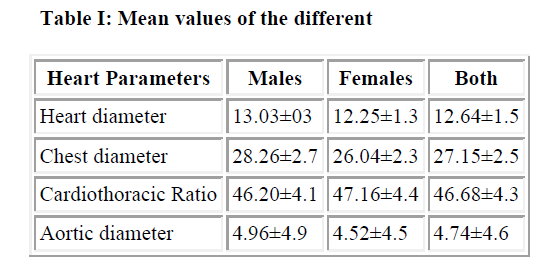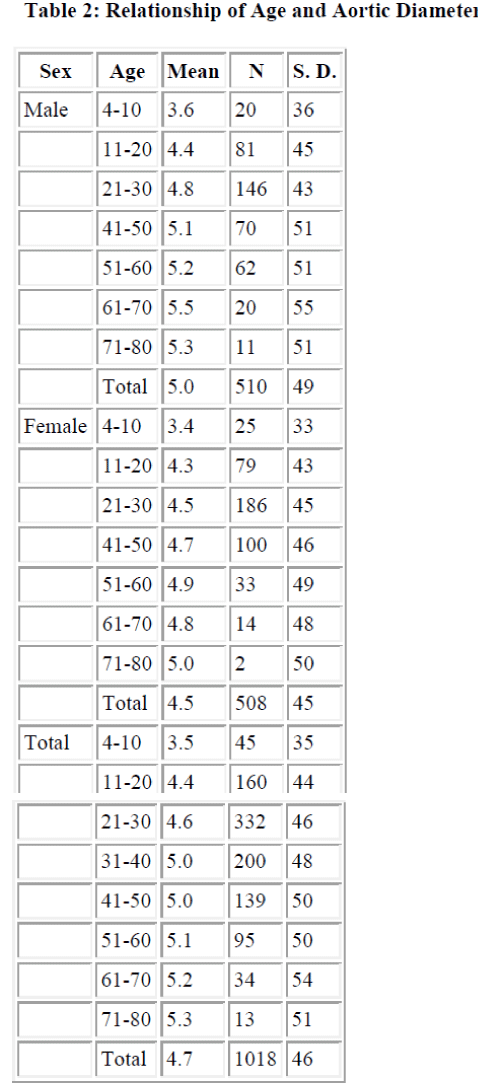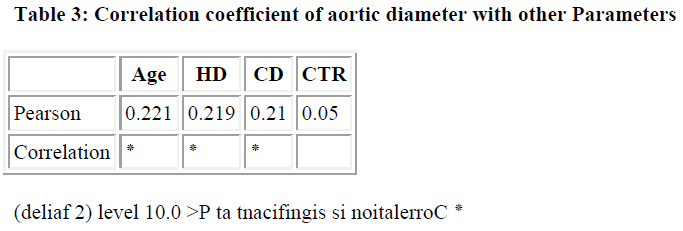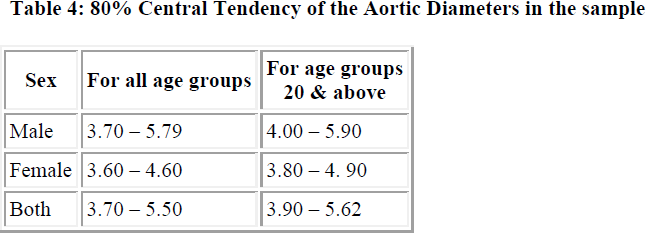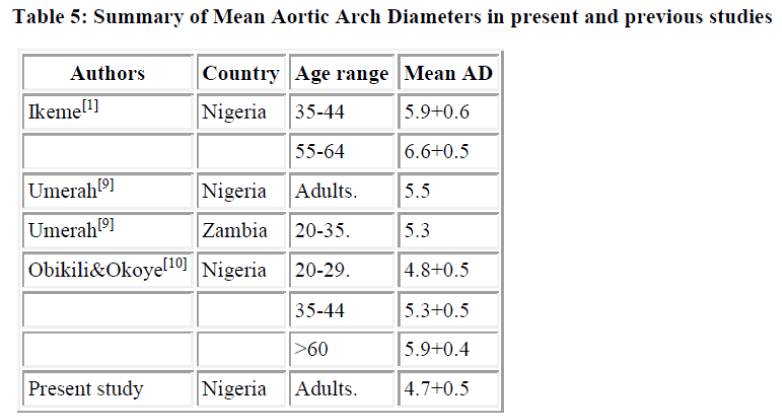ISSN: 0970-938X (Print) | 0976-1683 (Electronic)
Biomedical Research
An International Journal of Medical Sciences
- Biomedical Research (2007) Volume 18, Issue 2
Transverse aortic arch diameters and relationship with heart size of Nigerians within the South East
1Department of Anatomy, Enugu State University, College of Medicine, Enugu, Nigeria
2Department of Anatomy, Abia State University College of Medicine, Abia, Nigeria
- *Corresponding Author:
- Anyanwu G.E
Department of Anatomy
Enugu State University College of Medicine Enugu
Nigeria
E-mail: anyanwugemeks@yahoo.com
Accepted date: March 27, 2007
Several researches have been done on the establishment of normal aortic diameters at various levels. These researches have been done on the Caucasians as few studies have been within Africa using Africans. This work was designed to establish the transverse aortic arch diameters of Nigerians within the southeast and to establish the relationship of these values with the heart diameter, age and sex. PA chest radiographs of 1018 individuals of age 4 - 80 years were used for this study. The research presented a mean value of 4.7+0.46 for the aortic arch diameter of the Nigerian population. Mean aortic arch diameters for various age groups have been established. The research also set lower and upper limits of normal aortic arch diameter for the two sex groups, the entire distribution and for the distribution of males and females above age 20. The research noted higher values of aortic arch diameter in males than in females of same age group. Age and heart diameter showed strong, positive statistically significant relationships with aortic diameter. This diameter was noted to be slightly less than a third of the heart diameter within all the age groups.
Keywords
Aortic arch diameter, Heart diameter, Southeastern Nigeria, Chest radiograph.
Introduction
Determination of the heart size plays a crucial role in clinical diagnosis of healthy or failing heart. In this measurement, various imaging methods abound, but the chest X-ray has appeared to be most common, and the most readily used due to cheap affordability and simplicity. The aortic arch diameter is part of the structures seen in a posteroanterior chest radiograph and invariably radiological examination of the heart includes the aorta. Increases in the transverse diameter of the arch of aorta have severally been associated with hypertension and cardiac dysfunction. Enlargement of the aortic shadow as seen in the chest radiograph has been associated with symptomless [1,2] made a strong association between the aortic diameter with blood pressure.
Several researches have been done on the establishment of normal aortic diameter at various levels, but the majority of these researches have been amongst Caucasians [3-5]. With increase in the prevalence of cardiovascular dysfunction in Nigeria within the last decade [6], it becomes an issue of concern for such values as the normal aortic diameter and its relationship with sex, age and heart size to be established using the Nigerian population.
Materials and Method
The study was carried out in the University of Nigeria Teaching Hospital (UNTH) Enugu, Nigeria, and Hansa, Special Diagnostic Centre, Enugu, Nigeria. 1018 postero-anterior chest radiographs were used for this research out of a total of 1885 chest radiographs of candidates physically examined and enrolled into the research. These samples included both sexes, from the ages of four and above. This sample population was selected from candidates that came for chest X-ray examination as a result of requirements such as preemployment, preadmission, visa application and volunteer candidates without signs of any cardiothoracic disease symptoms. The PA chest radiographs of all the candidates were taken in the erect position with a film focus distance of 1.8m. The exposures were made at normal quiet inspiration.
Subject’s name, sex, age, medical history noted. Measurements of the candidate’s blood pressures were taken, and the values accepted to be normal for this research were cases where the systolic blood pressure fell between 110 and 145mmHg and the diastolic pressure between 60 and 110mmHg.
The width of the aortic shadow was measured as the sum of the maximum extension of the aortic shadow to the right and to the left of the midline [7]. The transverse heart diameter was obtained by measuring the horizontal distance between the most rightward and leftward borders of the heart as is seen in the chest radiograph while the transverse thoracic diameter was measured as the horizontal distance inside the rib at the widest point above the costophrenic angles as is seen on a PA chest radiograph. The cardiothoracic ratio (CTR) was derived using the formula as described elsewhere by Danzer [8].

Result
Male candidates made up 510 number of the sampled population while the females made up the rest 508. Age ranged from 4 to 80 years with age 32.8 as the mean age of the distribution. Aortic heart and chest diameters were measured in centimeters. Table I gives the summary of the mean values of the measured parameters, while table 2 gives the distribution of the aortic diameters by age.
Table 3 shows the various correlation values of aortic arch diameter, with age, heart diameter and chest diameter. It reports high positive and statistically significant relationship between aortic diameter with age, heart diameter. Table 4 shows the upper and lower limits for which values of aortic diameters in the sampled population should be considered normal. The limits chosen are the central 80% percent range of the distribution. The 10th and 90th percentile of the distribution though still normal (because all the subjects considered were all healthy.) were both cut off. By so doing, the extremes of values of the distribution for which the occurrences are relatively infrequent are edited out. Table 5, gives a comparative summary of some previous studies with the present study.
Discussion
This research has presented a mean value of aortic arch diameter for the Nigerian population. It also has given mean values of the same diameter for various age groups. This research also, has set upper and lower limits for normal aortic arch diameters within the Nigerian ethnicity. The mean value of 4.7+0.5 reported in this work is significantly lower than some previous works done in Nigeria and Zambia [1,9,10]. Obikili and Okoye [10] suggested differences in methodology of measurement for some of these variations also noted in their study.
This research records larger values of aortic diameter in males than the females of same age group in conformity to the observations of the earlier researchers [1,10]. However, Stuart et al [2] made a different observation where they recorded a larger value of aortic diameter for females than males of the same age group, in his study of Jamaican population. This he attributed to higher blood pressure levels found in women.
Our results showed a strong positive correlation with aortic arch diameter which is in agreement with the reports of earlier investigators [9-12]. Aortic arch diameter correlated positively and strongly with chest and heart diameters. The aortic diameters were slightly more than a third of the heart diameters in all the age groups and entire population.
References
- Ikeme AC, Ogakwu MN, Nwakonobi FA. The significance of the enlargement of the aortic shadow in adult Nigerians. Afr J Med Sc 1976; 5: 1995-1999.
- Stuart KL, Miall WF, Tulloch JA et al. Dilation and Unfolding of the aortic in a Jamaican population Br Heart J 1962; 24: 455-463.
- Munks A. Darage K, Wiesel M et al. Diameter of the Infrarenal aortic and the iliac arteries in children: ultra-sound measurements. Transplantation 2002; 27: 73 (4) 631-635.
- Sonesson B, Canne T, Hansen F. Infraenal aortic diameter in the healthy person. Euro J Vasc Surg. 1994; 1: 89-95.
- Sariosmaoglu N, Ugurlu B, Karacelik M et al. A multicentre study of abdominal aorta diameters in a Turkish population. J Int Med Res 30: 1-8.
- Udemezue OO, Akpuaka FC, Anibeze CIP et al. Body Habits and Abdominal aortic sizes among South Nigerian. J. Exp & Clin Anat 1: 22-25.
- Rose GR, Black Burn H. Cardiovascular population study methods. Geneila WHO monographs.
- Danzer CS. The cardiothoracic ratio: An Index of cardiac enlargement Am J. Med. Sc 157: 513.
- Umerah BC. Unfolding of the aortic (Aortitis) associated with pulmonary tuberculosis Br J Radiol. 1982; 55: 201-203.
- Obikili EM and Okoye IJ. Aortic Arch diameter in a frontal chest radiographs of a normal Nigerian population. Nig J Med 2004; 2: 171-74.
- Ungerleinder HE, Gubner RI. Evaluation of heart size measurements. Am Heart J 1942; 24, 494-510.
- Gustafson J, Fredenberg J. Evaluation of left heart disease by statistical analyses of aortic parameters. Am Heart J 1965; 64: 479.
